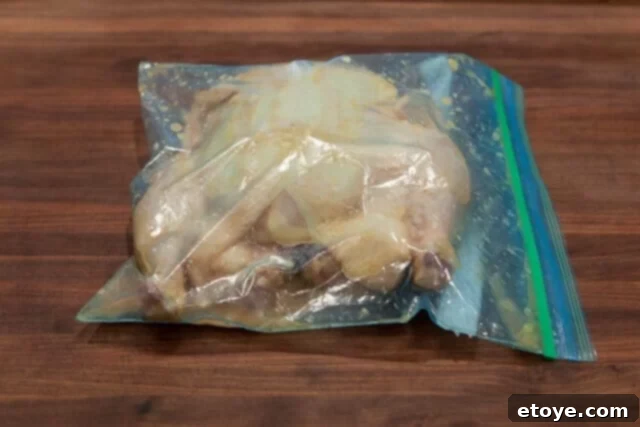Embark on a delightful culinary adventure with our Miso Roast Chicken recipe, a dish that masterfully blends savory umami with the comforting familiarity of a perfectly roasted bird. This recipe, initially developed for our client Miso & Easy, showcases the incredible versatility and depth that miso paste brings to everyday cooking. Whether you opt for their convenient ready-made miso or a premium miso paste from your local grocery store, the outcome is a remarkably flavorful and tender chicken that will become a new family favorite. My personal recommendation for this recipe is shiro miso, often referred to as white miso. Its delicate, slightly sweet profile and lower sodium content make it an ideal choice, allowing the chicken’s natural flavors to shine through while infusing it with an irresistible, subtle richness. This Miso Roast Chicken is not just a meal; it’s an experience, promising both gourmet taste and cooking simplicity.

This past summer has been a whirlwind of travel, accumulating airline miles across various cities: New York City, Chicago, Las Vegas, Salt Lake City, and then New York City again, with another trip to Buffalo last week, and back to New York City tomorrow to speak at the prestigious BlogHer conference. Amidst this bustling schedule, our recent visit to Buffalo held a special significance as we spent cherished time with Scott’s mom, affectionately known as “Mimi.” In the wake of a profound loss, where time can stretch and warp with the weight of sorrow, our family has focused on providing unwavering support to Mimi. It has been only three months since Papa passed away, and navigating life without him has been a journey of adjustment for us all, especially for Mimi. We’ve been diligently helping her with various tasks, from streamlining finances and untangling complex insurance bills to tackling home repairs, tech questions, and all the myriad responsibilities Papa meticulously managed. The geographical distance between us in Florida and Mimi living alone in Buffalo, NY, presents its challenges, but through consistent video calls, emails, Skype, and good old-fashioned telephone conversations, we’ve managed to stay connected and offer the support she needs.
Conventional wisdom often suggests that a widow should remain settled for at least six months after the loss of a spouse, avoiding major life changes or extensive travel. Mimi, with her remarkable resilience and strength, has embraced this philosophy beautifully. She has forged a new routine for herself, finding purpose and connection through her continued work at the local quilt shop, enjoying regular lunches with dear friends, and participating in engaging outings with her neighbors. It’s inspiring to witness her rebuilding a fulfilling life, honoring Papa’s memory while carving out her own path forward. The true highlight of our visit, a moment that warmed our hearts each day, was watching our boys. They would sneak out of their beds every morning, tiptoeing quietly across the floor to snuggle up with Mimi on the couch, offering her comfort and filling her home with innocent joy and affection. These small, tender moments created lasting memories and underscored the enduring strength of family bonds, providing a beacon of warmth during a time of transition.
Cooking in Mimi’s kitchen felt like stepping back in time, a deeply grounding experience that contrasted sharply with my own modern culinary space. There, I used the same sturdy knives she’s owned for over three decades, a seasoned roasting pan that likely predates me, and an aged, solid walnut cutting board that Scott has been using since he was a little boy. Every utensil, every piece of equipment, whispered stories of countless meals prepared, family gatherings celebrated, and comforting dishes shared over generations. It was a tangible connection to the past, a kitchen imbued with a profound sense of history.
In my own kitchen, I confess to being somewhat spoiled by the sleek efficiency of shiny new electronics, an array of brand-new tools, and a collection of vibrant silicon spatulas. It’s a cook’s treasure trove of gadgets, designed for maximum convenience and performance. Yet, despite all the modern amenities and cutting-edge equipment, there’s an undeniable element my kitchen currently lacks: history. Mimi’s kitchen, in its understated simplicity and well-worn charm, possesses a soul that no amount of gleaming stainless steel or smart technology can replicate. It’s a reminder that sometimes, the most valuable ingredients in a kitchen aren’t just found on a shelf, but are built up over years of love, laughter, and shared moments.

Miso Roast Chicken Recipe: A Flavorful and Foolproof Method
Preparing a whole roast chicken can sometimes seem daunting, but with the right technique, it transforms into an incredibly straightforward and rewarding experience. This Miso Roast Chicken recipe utilizes a method that guarantees a perfectly cooked, juicy, and flavorful bird every time: spatchcocking. Also known as butterflying, spatchcocking involves removing the backbone from a whole chicken, allowing it to lay flat. This simple yet revolutionary technique dramatically reduces cooking time, promotes incredibly even roasting, and ensures every part of the chicken, from breast to thigh, cooks uniformly to succulent perfection. The flattened profile also exposes more skin to the heat, leading to an incredibly crispy, golden-brown exterior that is absolutely irresistible. As an added bonus, carving the spatchcocked chicken becomes significantly easier, often requiring nothing more than a small knife, making serving a breeze.
How to Spatchcock a Chicken: A Step-by-Step Visual Guide
Spatchcocking might sound intimidating, but it’s an incredibly simple technique that will elevate your roast chicken game. Follow these easy steps to butterfly your chicken like a pro:
Step 1: Prepare Your Chicken. Lay the chicken breast side down on a clean cutting board, ensuring the back is facing directly upwards. The drumsticks should naturally point away from you, providing a stable base for the next steps.

Step 2: Identify the Backbone. The backbone runs along the center of the chicken’s back. You’ll want to cut along both sides of this bone. Equip yourself with a pair of sharp kitchen shears; they are essential for making clean, effortless cuts through bone.

Step 3: Make the First Cut. Using your kitchen shears, carefully cut approximately 3/4″ to one side of the backbone, starting from the tail end and cutting all the way up towards the neck. Apply firm, steady pressure.

Step 4: Repeat on the Other Side. Now, make an identical cut 3/4″ to the other side of the backbone. Once both cuts are made, the backbone should be completely detached from the chicken.

Step 5: Remove the Backbone. Carefully lift and remove the backbone. Don’t discard it! This backbone is a treasure trove of flavor and can be saved to make rich, homemade chicken stock, enhancing future soups, sauces, or gravies. Store it in a freezer bag for later use.

Step 6: Flatten the Chicken. With the backbone removed, you’re left with a butterflied chicken. Flip the chicken over so the breast side is facing up. Place your palms firmly on the breastbone and press down hard until you hear a slight crack. This flattens the chicken, ensuring it cooks evenly and consistently. You’ll see that it now lays beautifully flat and ready for marinating.

Now that your chicken is perfectly spatchcocked, it’s ready to absorb the incredible flavors of our miso marinade. For optimal flavor penetration and tenderness, I highly recommend marinating the chicken in a resealable plastic bag overnight in the refrigerator. This allows the miso, ginger, and garlic to work their magic, permeating the meat and delivering a truly unforgettable taste. However, if time is of the essence, don’t fret! This recipe is incredibly forgiving. You can simply slather the luscious miso marinade onto the chicken and place it directly into the oven. Even a quick 30-minute marinade will impart fantastic flavor, proving that a delicious meal is always within reach.

Here are the simple yet powerful ingredients you will need to create this succulent Miso Roast Chicken:

When you’re ready to cook, retrieve your marinated chicken. Lay it flat, skin side up, in a sturdy roasting pan. It’s crucial to arrange the chicken so that the legs are positioned outwards and downwards, ensuring that all of the skin is exposed and facing upwards. This maximizes contact with the heat, guaranteeing a golden-brown, crispy skin that’s the hallmark of a perfectly roasted chicken. Preheat your oven to a robust 425°F (220°C) to jumpstart the crisping process.

Roast the chicken in the preheated oven for an initial 20 minutes. This high heat blast is essential for rendering the fat and achieving that coveted crispy skin. After this initial period, loosely cover the chicken with tin foil. This prevents the skin from over-browning while allowing the internal meat to cook through gently. Continue roasting for an additional 25 to 30 minutes, or until a meat thermometer inserted into the thickest part of the breast (without touching bone) registers 165°F (74°C). Once cooked, remove the chicken from the oven and let it rest, still loosely covered, for at least 10-15 minutes. This resting period is critical; it allows the juices to redistribute throughout the meat, ensuring every bite is incredibly tender and moist. Slice and serve with your favorite sides for an unforgettable meal.

For those who love the smoky char and distinct flavor that only a grill can provide, grilling your spatchcocked chicken is an even more fantastic option! The beauty of the butterflied chicken truly shines on the grill, as it lays perfectly flat, ensuring maximum contact with the heat and even cooking. Preheat your grill to a medium-high heat, creating two zones if possible (one hotter, one slightly cooler). Lay the chicken skin side down directly on the heated grill grates. Notice how beautifully and evenly it lies flat on the grill, a testament to the spatchcocking technique.
Grill the chicken, skin-side down, until the skin is beautifully browned and develops tantalizing char marks, typically 15-20 minutes depending on your grill’s heat. Monitor closely to prevent burning. Once the skin is perfectly crispy and golden, carefully flip the chicken to continue cooking on the other side. Transfer it to the cooler zone of the grill, cover, and cook until the internal temperature reaches 165°F (74°C). This two-zone method helps cook the chicken through without drying it out, while still achieving that incredible grilled flavor. Rest for 10 minutes before carving and serving, allowing the juices to redistribute for maximum succulence. Enjoy this smoky, savory, and perfectly cooked Miso Roast Chicken straight from the grill!

Miso Roast Chicken Recipe
Pin Recipe
Ingredients
- 1 whole chicken (about 4 pounds)
- 2 cloves garlic, minced
- 1 tablespoon minced fresh ginger
- 2 tablespoons miso paste (or 3 tablespoons Miso & Easy for a bolder flavor)
- 1 tablespoon cooking oil (like neutral grapeseed or canola oil)
- 1 tablespoon mirin (Japanese sweet cooking wine)
Instructions
- To spatchcock the chicken, begin by placing the chicken breast-side down on a clean cutting board, so the back is facing you (the drumsticks should be facing up). Using sharp kitchen shears, carefully cut approximately 3/4″ to each side of the backbone, working your way from the tail end up to the neck. Once both cuts are made, remove the entire backbone and set it aside for making delicious homemade stock. Flip the chicken over so the skin side is now facing up. Press down firmly on the breastbone with the heels of your palms until you hear a slight crack and the chicken lays flat and even.
- In a large, resealable plastic bag, combine the minced garlic, minced fresh ginger, miso paste, cooking oil, and mirin. Place the spatchcocked chicken into the bag, ensuring all surfaces are thoroughly coated with the miso marinade by gently massaging it into the chicken. For best flavor, refrigerate the chicken for a minimum of 30 minutes, or ideally, overnight. If you’re short on time, you can proceed directly to cooking after coating.
- Preheat your oven to 425°F (220°C). Place the marinated chicken, skin side up, in a sturdy roasting pan. Ensure the chicken is laid completely flat, arranging the legs so that the thighs are also facing upwards, maximizing skin exposure for crisping (refer to photos for visual guidance). Roast in the preheated oven for 20 minutes to achieve a golden, crispy skin. After 20 minutes, loosely cover the chicken with tin foil to prevent over-browning. Continue roasting for an additional 25-30 minutes, or until an instant-read meat thermometer inserted into the thickest part of the breast registers 165°F (74°C). Once cooked, remove the chicken from the oven and let it rest, loosely covered, for 15 minutes before carving and serving. This resting period is crucial for juicy results.
